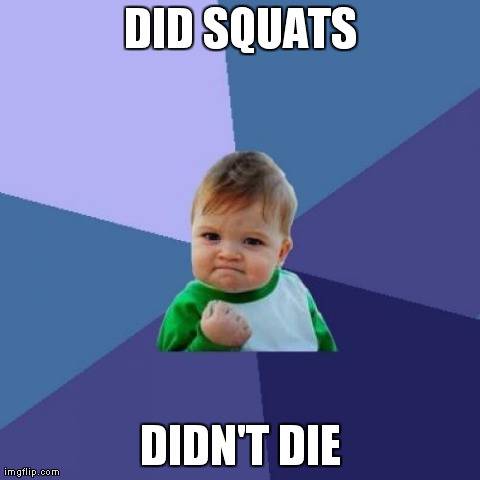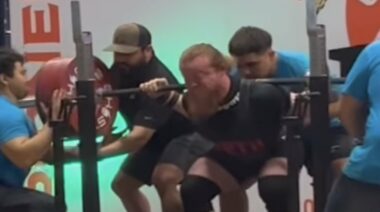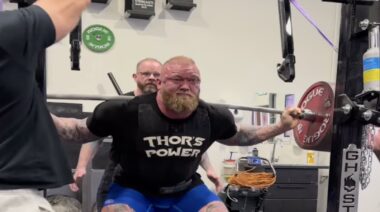Everyone makes mistakes. I make a lot. Everyone squats. (Don’t they?) I squat a lot. Through the combination of these two things, in addition to coaching a lot of squats, I’ve worked out eight common mistakes that limit squatting potential. Thankfully, I’ve also worked out how to correct them. Have a read over this list and see if you recognize any of these mistakes in yourself or others.
Mistake #1: Squatting Too High
If all the Internet memes are to be believed, squatting deep is possibly the meaning of life. While this is not quite true (everyone knows deadlifts are the meaning of life), squatting deep makes a whole load of sense, beyond proving doctors wrong and motivational posters right. I always think of squatting deep as something that is counterintuitive. When you have a heavy weight on your back, the last thing you want to do is to squat deeper with it. However, getting your ass to the grass has a number of direct benefits to you. You can harness the power of your glutes and hamstrings far better. It also puts you in a better position to get your hips directly underneath the bar quickly. Both of these things actually make the squat easier and have direct transfer to Olympic weightlifting (think getting pinned at rock bottom under a heavy clean.)
Mistake #2: Having Pins That Are Too High
Nope, nothing to do with long legs. In fact, this is the opposite. For those of us who are vertically challenged, we need to ensure we don’t challenge ourselves further by working off pins that are set too high on the rack. By the time you’ve gotten onto your tip-toes to get the weight off the rack, you’ll have lost a good deal of the tension you’ve worked so hard to generate. So don’t be lazy. Move the pins to a height that suits you. Slightly too low is better than slightly too high.
Mistake #3: Being Unconfident
One of the cues I use most often, out of both necessity and effectiveness, is “confident hips.” You know the type of squat I’m talking about – the one where there are no glaring technical issues, but the squat still looks unstable and unconfident, particularly on the way down. It can look like the hips are making their way down in an “S” shape, unsure which way they are going. Cueing confidence with the hips allows the squatter to focus on moving one part of the body correctly and confidently. Whichever style of squat you are going for, when you create a confident path with the hips, many other aspects of the squat will tend to fall into place.

Mistake #4: Always Wearing Assistance Gear
I’m the first person to advocate the use of legitimate lifting accessories, such as belts and knee wraps. They can be powerful aids in allowing your whole body to experience the strengthening benefits of heavier squats, while also keeping injury at bay. However, save these accessories for when it matters. Take a belt, as an example. I believe wearing a belt can actually help to teach the lifter to brace hard (rather than lessen the lifter’s ability to create pressure, as is commonly believed). However, I also believe that lifting beltless has great benefits in terms of creating and maintaining pressure and position, too. Get the best of both worlds, and use the belt when it gets heavy. Actually, just before it gets heavy, as using a belt is a skill to be learned just like any other.
Mistake #5: Breathing Incorrectly
I see this mistake take many forms. Two of the most common are taking a breath as you make your way down to the bottom, and taking a breath into your chest as opposed to into your belly. In fact I’ve often seem both together, and I put this down to the fact that taking a breath into your chest has little impact on the lifter in terms of anything else apart from intake of oxygen, so when it’s done doesn’t really matter either. The two fixes are simple. Point one: take a breath into your belly. This works to create intra-abdominal pressure to make your squat safer and more effective. Point two: this breath should be done before you begin this lift, just as you wouldn’t put your belt on after starting your lift. Maximize pressure before you begin your descent.

Mistake #6: Going Too Heavy Too Often
All you badasses out there will disagree I am sure, but yes, there is such thing a squatting too heavy. Actually, I’ve changed my mind. There isn’t such thing as squatting too heavy, as when you do so, you are no longer doing a squat. You’re doing some bastardized version of the lift. If you’re all caved in on a front squat or your back squat looks more like a good morning, then you are risking injury and training crappy movement patterns. Yes, it happens from time to time, but don’t make a habit of training this way or your body will think that is how it should be done.
Mistake #7: Never Failing
Not to be confused with going to heavy too often, this is in fact the concept of not going heavy enough, due to not having the balls to do so fear of getting pinned under a heavy bar. Almost always, as with many things, the fear is worse than the reality, and the only way to overcome it is to experience failure. In this situation, I may choose to take the lifter up to and through a controlled fail, with good spotters and under my watchful coaching eye. More often than not with this type of lifter the mind gives up before the body does. Form remains intact, but the lifter has given up mentally and is unable to make it out of the bottom of the squat. However, I have found a controlled practice of failure helps to alleviate the fear of being stuck, and gets the lifter to start making more aggressive choices with weight selection. If you’ve never failed a squat before (and I’m always surprised how many people haven’t), then consider this as an option.

Mistake #8: Being Too Quick Between Sets
Looking at this from a wider perspective, I can see lots of possible reasons why people don’t rest enough in between sets. The hasty pace of modern day living leaving little time to train, the desire to fit in as much training as humanly possible, and the CrossFit mentality of doing everything quickly are three potential reasons why I figure I often see squat sets performed back to back (there’s a pun in there somewhere). But to not allow adequate rest is to short-change yourself from strength gains. Allowing full recovery, or as close as possible, in between squat sets is going to ensure that you get the best out of every set. And before you tell me you don’t need the rest, that you are fine without it, have you ever tried it? I bet that not only could you lift heavier across more sets, but also the quality of your reps would improve, too. Rest more, lift more.
I hope this article has helped you. Do you see yourself or anyone you know in any of these points? Please feel free to spread the word if you recognize any of your friends and clients, and post below if you have any further questions. Here’s to better squatting!






